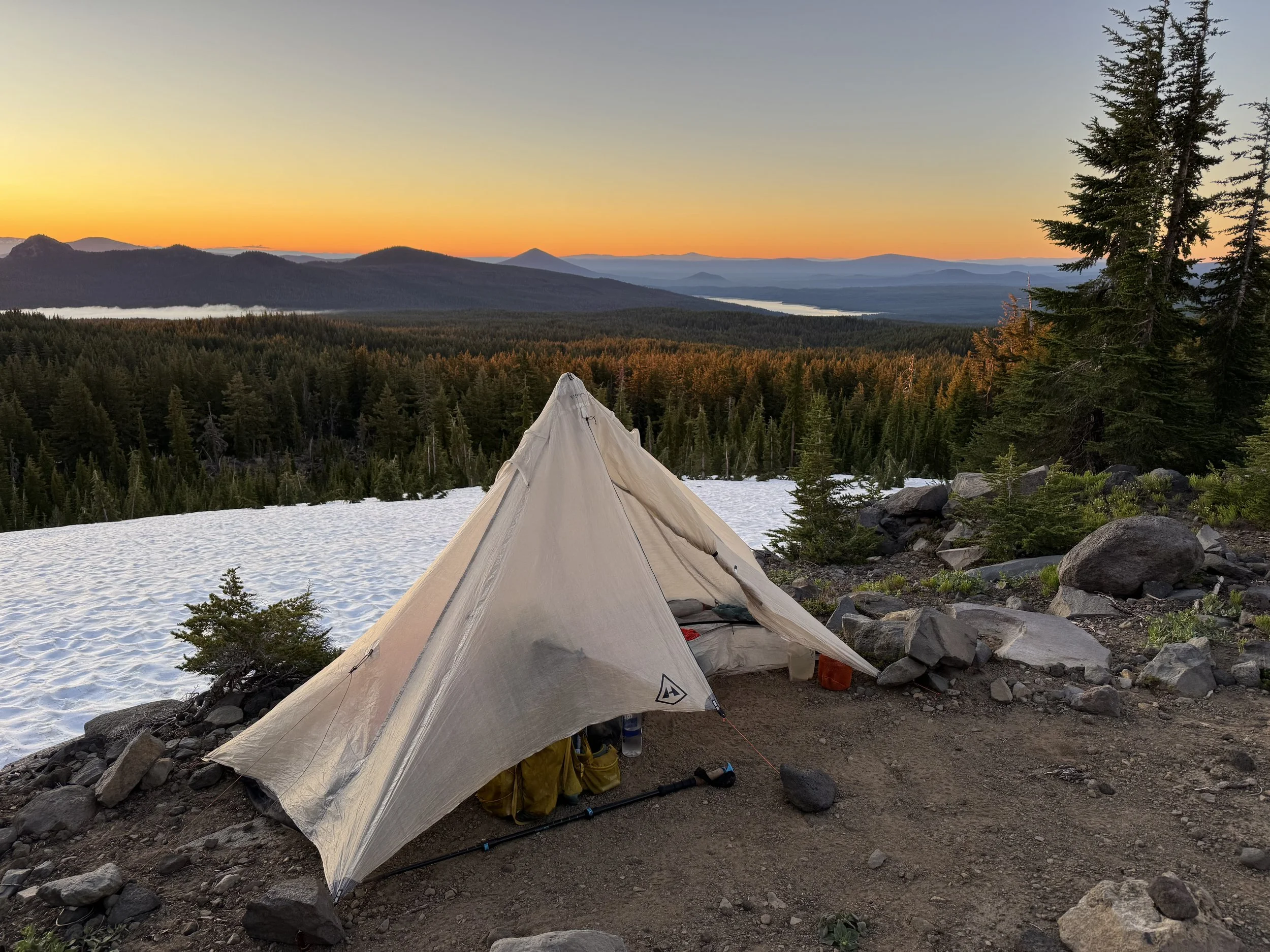Meditation with Varied Thrush
The Pacific Crest Trail between Crater Lake and Shelter Cove is still deeply covered in snow above 6500 feet. In some places, a stretch of sunny bare trail leads abruptly to a 10 foot pile of shaded snow which has to be scaled. At higher elevations, the entire forest floor is still covered. Route finding has been difficult and my progress is slow through these areas. Not to mention the fact that the tread on my shoes is very worn down, so I am slipping and sliding more than usual, which makes travel more exhausting. In the Diamond Peak wilderness, the whole situation is complicated by multiple avalanches that have come through the area bringing down small trees, Douglas fir and western hemlock, which criss cross the would-be trail. The snow is soft enough in places that I occasionally break through the surface and post-hole down to whatever lies below. In other places, it is hard enough that I slip frequently and lean heavily on my poles. Each snow section takes a lot of concentration and effort. I am alone, sweating, feeling pretty exhausted and ready for this to be over. Finally, I see a melted out section of forest with a comfortable looking place to sit down and catch my breath. Then I hear it, the mysterious, eerie song of the varied thrush whistling through the coolness of the morning. I close my eyes and let the tingling energy of my body dissolve into the the watery whistle of the bird and the feel of my breath.
Breathing in, the high note, or several notes together, hopeful, anticipating, magical. I feel my whole body vibrating and alive. Breathing out, the low note comes in a familiar, eerie minor key. I sink more deeply into the forest floor supporting me as I lean against my pack.
The varied thrush can produce two notes at the same time creating a sound that is sometimes harmonious but often dissonant. There is generally a high note followed by a low note, each sustained for 2-3 seconds and suspended in a backdrop of silence. The vibrating quality of each tone makes it sound like a whistle that has water in it. The spacing of each tone has a rhythmic effect reminiscent of the in-breath followed by the out-breath. I sit for a long time disappearing into the sound, letting my body become vibration and sensation. Though I did not know its name back then, this is the bird that narrated many of the hiking adventures of my youth in these mountains. It is both familiar and haunting, sentimental and melancholy.
I am completing the 85 mile section of the Oregon PCT that was closed last year due to forest fires. I was lucky to be escorted on this trip by my friend Jean, the same friend who helped me start the PCT this time last year. She turned around after day one to get back to work, but she helped me drop a car off at my finishing point which is a huge comfort. There are not very many hikers on the trail at this time of year. Very few of the northbound hikers have made it this far yet, the SOBOs are just pushing off from the Canadian border, and the weekenders are waiting for snow to melt. I have seen a few section hikers completing this previously closed section same as me.
July is mosquito season just about anywhere on the PCT. It’s pretty hot and it’s necessary to stay covered up for both sun protection and bug protection. I was expecting this, but I was not expecting so much snow in the high country. Despite growing up in the Oregon Cascades, I have never been to this exact area before, so it feels both new and somehow deeply familiar to me at the same time.
When I get up from my resting place to continue hiking, I feel refreshed and much more alert and ready to patiently find my way through this difficult snow covered section. I reach out for a hemlock handhold as I skirt around a steep slick section of snow and my ears perk up at the sound of… what was that? A frog?! The meadows down below me are melting and the frogs are happily proclaiming their names to the emerging bog. I chuckle to myself. I don’t think I have ever been serenaded by a frog while hiking through a snowy forest swatting mosquitos while sweating and holding onto the tips of a horizontal hemlock trees for balance. I am so deeply grateful to be here.
Once I get below 6500 feet, the trail is relatively straightforward and fully melted. Heat and mosquitoes prevail as the sun glints off my now necessary bug net temporarily blinding me. I begin to wish for snow again and recognize that this is all part of it. Conditions are impermanent and always changing. The next 8 miles will be all down hill, and my car will be waiting at the end of this section for me. I will have hiked all of Oregon’s PCT.
The cheerful sound of the yellow-rumped warbler pierces the air. Breathing in, I feel gratitude and wonder, breathing out, I smile.
Poetry Reference:
I'm nobody! Who are you?
Are you nobody, too?
Then there's a pair of us -- don't tell!
They'd banish -- you know!
How dreary to be somebody!
How public like a frog
To tell one's name the livelong day
To an admiring bog!
Emily Dickinson

